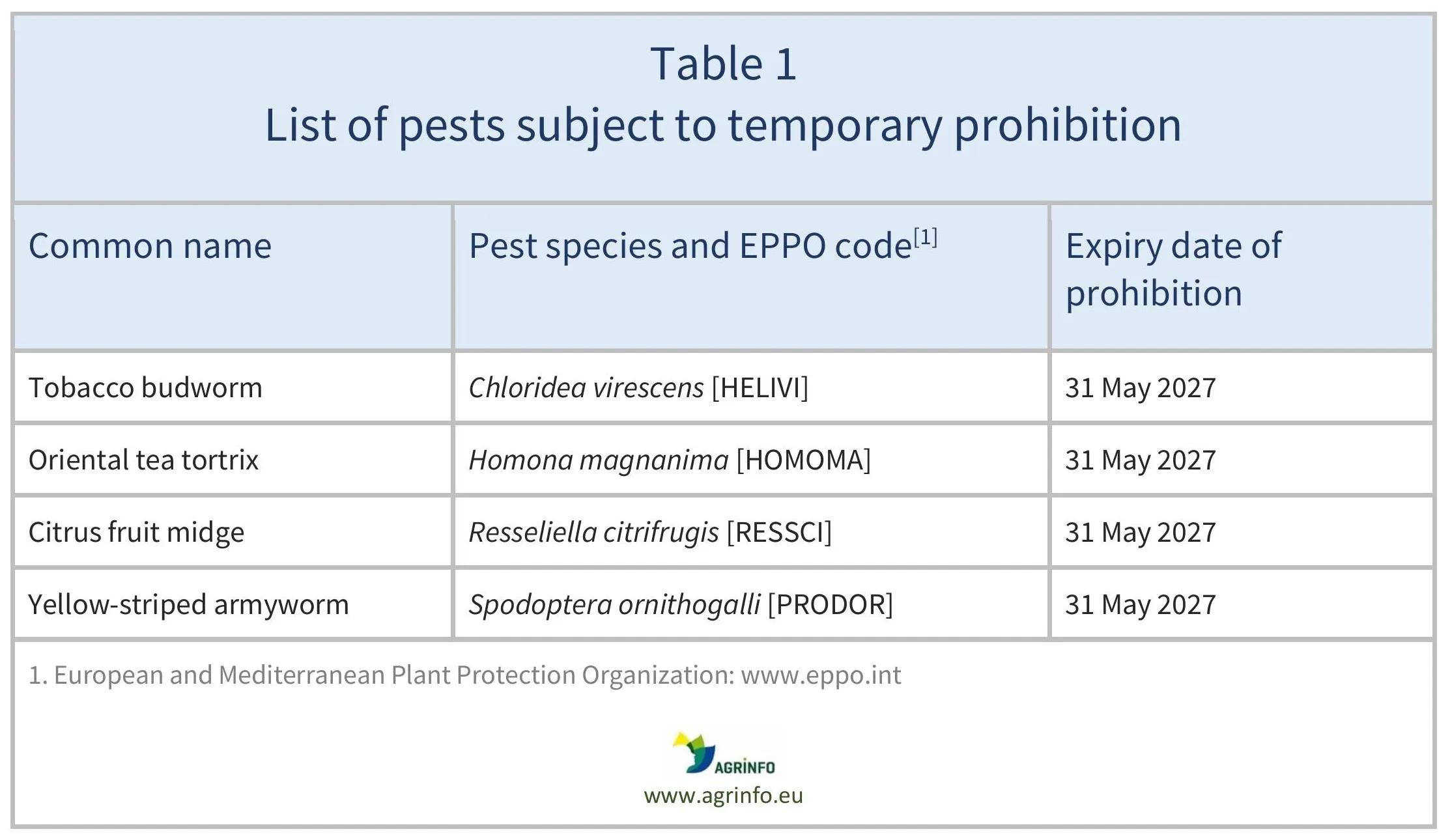Revision of plant pest temporary prohibition lists
- Plant health
- Priority pests
Summary
The European Union (EU) has removed the snout moth (Leucinodes pseudorbonalis) from the list of pests temporarily prohibited from being introduced into the EU territory because it is considered to be a very low risk. The eggplant fruit and shoot borer (Leucinodes orbonalis) was removed from the list in 2024 for the same reason. The Oriental tea tortrix (Homona magnanima) was added to the list in 2024 due to risk concerns.
EU removes snout moth (Leucinodes pseudorbonalis) as prohibited pest
Commission Implementing Regulation (EU) 2025/356 of 21 February 2025 amending Implementing Regulation (EU) 2022/1941 as regards the prohibition of introduction, movement, holding, multiplication or release of certain pests
Commission Implementing Regulation (EU) 2024/1957 of 17 July 2024 amending Implementing Regulation (EU) 2022/1941 as regards the prohibition of introduction, movement, holding, multiplication or release of certain pests
Update
The European Union (EU) has removed the snout moth (Leucinodes pseudorbonalis) from the list of pests temporarily prohibited from being introduced into the EU territory because it is considered to be a very low risk. The eggplant fruit and shoot borer (Leucinodes orbonalis) was removed from the list in 2024 for the same reason. The Oriental tea tortrix (Homona magnanima) was added to the list in 2024 due to risk concerns.
Impacted Products
Apple, aubergine (eggplant), citrus, peanut, pears, persimmon, soybean, stone fruit, sweet cherry, tanbark, tea
What is changing?
The EU regularly updates the list of pests (listed in the Annex of Regulation 2022/1941) that are temporarily prohibited from introduction into the EU on the basis of available scientific evidence.
The snout moth (Leucinodes pseudorbonalis) has now been removed from that list. This follows the removal in 2024 of the eggplant fruit and shoot borer (Leucinodes orbonalis).
The Oriental tea tortrix (Homona magnanima) was added to the list in 2024, following its discovery in imported produce intercepted at EU border controls (CABI 2020; JKI 2024).
See Table 1 for the updated list.
Why?
EU Member States notify the European Commission of the presence of new pests in consignments that are intercepted during border controls. If they are not already classified as Union quarantine pests, but pose a significant risk, these pests are temporarily added to the list pending further assessment and potential addition to Annex II of Regulation 2019/2072. The removal of Leucinodes pseudorbonalis follows an evaluation by the European Food Safety Authority (EFSA 2024a, 2024b).
The list of regulated pests is updated on an ongoing basis according to the most recent scientific evaluations.
Timeline
The revised list of prohibited pests applies from 16 March 2025.
Background
Regulation (EU) 2022/1941 prohibits the introduction, movement, holding, multiplication, or release of certain pests within the EU territory.
When EU Member States notify the Commission of the presence in consignments of new pests that are not listed as Union quarantine pests, but pose a significant risk, these pests are temporarily included in the list pending further assessment and potential addition to Annex II of Regulation 2019/2072.
Resources
CABI (2020) Homona magnanima (oriental tea tortrix). PlantwisePlus Knowledge Bank.
EFSA (2024a) Pest risk assessment of Leucinodes orbonalis for the European Union. EFSA Journal, 22(3): e8498.
EFSA (2024b) Pest risk assessment of African Leucinodes species for the European Union. EFSA Journal, 22(4): e8739.
JKI (2024) Express PRA for Homona magnanima – Interception. Julius Kühn-Institut, 6 June.
Regulation (EU) 2024/1957 as regards the prohibition of introduction, movement, holding, multiplication or release of certain pests
Regulation (EU) 2022/1941 on the prohibition of introduction, movement, holding, multiplication or release of certain pests
Commission Implementing Regulation (EU) 2019/2072 as regards protective measures against pests of plants
Sources
Commission Implementing Regulation (EU) 2025/356 as regards the prohibition of introduction, movement, holding, multiplication or release of certain pests
Commission Implementing Regulation (EU) 2024/1957 as regards the prohibition of introduction, movement, holding, multiplication or release of certain pests
Tables & Figures

Source: based on Regulation 2025/356 (Annex)
Disclaimer: Under no circumstances shall COLEAD be liable for any loss, damage, liability or expense incurred or suffered that is claimed to have resulted from the use of information available on this website or any link to external sites. The use of the website is at the user’s sole risk and responsibility. This information platform was created and maintained with the financial support of the European Union. Its contents do not, however, reflect the views of the European Union.
EU removes snout moth (Leucinodes pseudorbonalis) as prohibited pest
Commission Implementing Regulation (EU) 2025/356 as regards the prohibition of introduction, movement, holding, multiplication or release of certain pests
Commission Implementing Regulation (EU) 2024/1957 as regards the prohibition of introduction, movement, holding, multiplication or release of certain pests
What is changing and why?
The European Union (EU) has updated its temporary list of prohibited pests (Regulation 2022/1941) based on recent plant health risk assessments.
The snout moth (Leucinodes pseudorbonalis) has been re-evaluated and removed from the list, as its risk to the EU was found to be low.
See Table 1 for the revised list of prohibited pests.
Timeline
The revised list of prohibited pests applies from 16 March 2025.
Tables & Figures

Source: based on Regulation 2025/356 (Annex)
Disclaimer: Under no circumstances shall COLEAD be liable for any loss, damage, liability or expense incurred or suffered that is claimed to have resulted from the use of information available on this website or any link to external sites. The use of the website is at the user’s sole risk and responsibility. This information platform was created and maintained with the financial support of the European Union. Its contents do not, however, reflect the views of the European Union.
